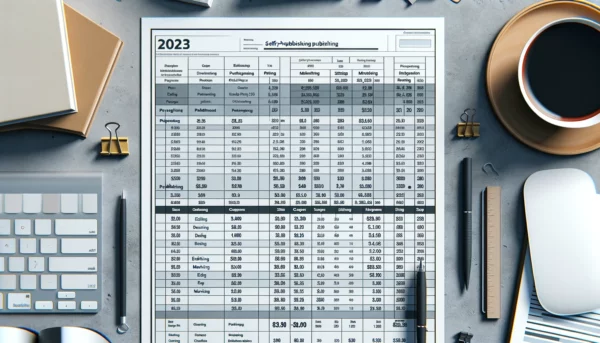Proofreading is like that one last look in the mirror before a big event—it’s the step that ensures you don’t step out with toothpaste on your shirt. Yet, surprisingly, 58% of business documents still contain grammar or spelling errors, according to a study by Templafy. These mistakes can cost credibility, professionalism, and even opportunities, especially if you’re self-publishing.
Think of it this way: your writing, whether it’s a novel, blog post, or business report, represents you. Do you want readers to focus on your creative brilliance or be distracted by comma splices and typos?
Even the best writers need a fresh set of eyes to catch the errors their brains naturally skim over. That’s where proofreading comes in—a non-negotiable step for error-free writing. Trust us, nothing kills a polished masterpiece faster than a rogue “there” instead of “their.” Let’s dive into the hows and whys of this crucial process.
What Is Proofreading?
Proofreading is the final stage in the writing process, where a document is meticulously reviewed to catch and correct errors. Think of it as a quality control check for your writing—it ensures the final version is polished, professional, and error-free.
What Does Proofreading Involve?
Proofreading focuses on surface-level issues such as spelling errors, grammar mistakes, punctuation inconsistencies, and formatting problems. Unlike editing, which deals with improving clarity and flow, proofreading is about identifying and fixing remaining errors after all major revisions are complete. For example, a proofreader might catch a missing period, a typo like “teh” instead of “the,” or a formatting issue with line spacing.
Why Is Proofreading Important?
Even the most experienced writers make mistakes—it’s only human. However, unchecked errors can confuse readers, disrupt the flow of your writing, and undermine your credibility. A study by Grammarly found that documents with typos and grammatical mistakes are perceived as 34% less professional. Whether you’re submitting a manuscript for traditional publishing, sending a business proposal, or posting an article online, proofreading ensures your work leaves the right impression.
Who Should Proofread?
Ideally, proofreading should be done by someone other than the writer. Fresh eyes—whether a professional proofreader or a trusted peer—are more likely to spot errors that the writer might overlook. Proofreading is the final safeguard against embarrassing mistakes and is a non-negotiable step in creating polished, professional writing.
Spelling Errors: A Common Pitfall
Spelling errors are some of the most noticeable and embarrassing mistakes in writing. They can sneak into your work even when you think everything is perfect. Spell check tools might catch obvious errors, but they’re far from foolproof—after all, they can’t distinguish between “their,” “there,” and “they’re.”
What Are Spelling Errors?
Spelling errors include typos, incorrect word usage, and misspellings that can confuse or distract the reader. For example, writing “bare with me” instead of “bear with me” completely changes the meaning of your sentence. Homophones (words that sound the same but have different meanings and spellings) are particularly tricky for writers.
Why Do They Matter?
Misspelled words can undermine your credibility, make your writing harder to understand, and give readers the impression that your work was rushed or careless. According to a BBC study, 42% of online shoppers say spelling errors on a website make them less likely to trust the business. Similarly, in a manuscript or document, spelling errors can create confusion and reduce the overall impact of your message.
How to Catch Spelling Errors
Proofreading is key to eliminating spelling mistakes. Reading your document aloud can help identify words that “sound” right but are written incorrectly. Printing the document and using a fresh set of eyes—or better yet, enlisting a professional proofreader—can also catch those sneaky errors that spell check tools miss. Remember, even small mistakes can leave a big impression on your readers!
Why You Need a Professional Proofreader
A professional proofreader is like the safety net beneath a tightrope walker—they ensure your writing doesn’t fall flat due to avoidable mistakes. While self-proofreading can catch some errors, an expert proofreader brings the skills and objectivity needed to polish your work to perfection.
What Does a Professional Proofreader Do?
A professional proofreader reviews your document with a trained eye to catch errors you may have overlooked, such as grammar mistakes, punctuation errors, formatting issues, and stylistic inconsistencies. They also ensure adherence to a specific style guide (like APA or Chicago Manual of Style) if required. For example, they might fix inconsistent capitalization in headings or ensure your citations are formatted correctly.
Why Hire a Professional?
The biggest advantage of hiring a professional proofreader is their objectivity and expertise. Writers are often too close to their work to notice every typo or misplaced comma. A professional proofreader approaches your document with fresh eyes and the sole focus of making it error-free. Studies have shown that professionally proofread documents are 60% less likely to contain errors compared to self-proofread ones (source: Scribendi).
When to Use a Professional Proofreader
If your work is high-stakes—like a manuscript for traditional publishing, a business report, or even an academic thesis—hiring an expert proofreader is a must. They ensure your final version meets the highest standards, leaving a lasting impression on your readers. Think of it as investing in your writing’s success!
Copy Editing vs. Proofreading: What’s the Difference?
At first glance, copy editing and proofreading might seem interchangeable, but they serve distinct purposes in the writing process. Both are essential steps to ensure polished writing, but understanding the difference helps you know which one you need.
What Is Copy Editing?
Copy editing focuses on improving the structure, clarity, and flow of your writing. A copy editor dives deeper into your text, checking for awkward phrasing, redundant sentences, and consistency in tone and style. For instance, they might rework a confusing sentence like, “The quick decision made by the committee on Tuesday was surprising,” into, “The committee’s swift Tuesday decision came as a surprise.” It’s about refining your message while maintaining its meaning.
What Is Proofreading?
Proofreading, on the other hand, happens after all major edits are complete. It focuses on surface-level issues like grammar errors, punctuation mistakes, spelling errors, and formatting inconsistencies. The goal is to catch any remaining errors before the document is finalized.
When Do You Need Each?
If your writing feels unclear or disorganized, a copy editor is your go-to. They’ll clean up your content and ensure it reads smoothly. However, if your document is already polished and you’re looking for that final error-free version, proofreading is the way to go. Both steps are crucial for creating professional, reader-ready content. Skipping one could mean more errors slipping through the cracks!
The Editing Process: From Draft to Final Version
Editing and proofreading are key parts of the writing process, but each plays a unique role in transforming your draft into a polished final version. Understanding the steps involved can help you organize your workflow and produce error-free, professional writing.
Step 1: Writing the Draft
The first step is putting your ideas on paper. At this stage, the focus is on creativity and content, not perfection. Expect typos, grammar errors, and structural inconsistencies—it’s all part of the process.
Step 2: Revising and Editing
Editing comes next, where the real polishing begins. This step includes revising the structure, improving clarity, and reworking sentences for better flow and meaning. A copy editor may step in here to help refine your content. For example, they’ll eliminate redundancies, ensure consistency, and tighten up wordy passages.
Step 3: Proofreading the Final Version
Once the editing is complete, proofreading ensures your work is error-free and ready for readers. This step catches remaining issues like punctuation mistakes, formatting problems, and stylistic inconsistencies. For instance, a proofreader might notice a misplaced apostrophe or inconsistent line spacing.
Why Follow the Process?
Skipping steps can lead to confusion, typos, or a lack of clarity in your writing. Each stage builds on the previous one, resulting in a document that’s professional, polished, and ready for submission or publication. The editing process isn’t just about catching errors—it’s about creating writing that truly shines.
Proofreading Tips for Error-Free Writing
Proofreading may seem daunting, but with the right techniques, you can catch mistakes and polish your work to perfection. Whether you’re proofreading your own writing or reviewing someone else’s, these tips will help you create error-free documents.
1. Take a Break
Stepping away from your work gives you fresh eyes when you return. Even a short break can help you spot typos and errors you might otherwise miss. Your brain is less likely to skim over mistakes after some time away.
2. Print It Out
Reading on paper instead of a screen can reveal formatting issues, punctuation mistakes, and grammatical errors you didn’t notice before. Use a pen to mark corrections directly on the printed page.
3. Read Aloud
Hearing your words can help you catch awkward phrasing, missing words, and stylistic inconsistencies. For example, a misplaced comma might disrupt the natural rhythm of a sentence when read aloud.
4. Use a Style Guide
If your document requires a specific format, like APA or MLA, make sure you follow the guidelines. This ensures consistency in citations, headings, and other formatting elements.
5. Focus on One Issue at a Time
Instead of trying to catch everything at once, proofread in stages. Start with spelling errors, then move to punctuation, grammar, and formatting.
6. Ask for a Fresh Set of Eyes
Sometimes, you’re too close to your own work to see mistakes. A trusted friend, colleague, or professional proofreader can help catch remaining errors and improve clarity.
By following these tips, you’ll make the proofreading process more focused and effective. Remember, even small corrections can make a big difference in your writing’s impact!
Common Errors and How to Avoid Them
Even the most meticulous writers can fall victim to common errors. These mistakes, while small, can distract readers, dilute your message, and make your writing appear unpolished. Identifying these issues is the first step to avoiding them.
1. Typos and Spelling Mistakes
Typos like “definately” instead of “definitely” or “teh” instead of “the” are easy to overlook, even with spell check. Spell check tools can’t catch everything, especially homophones (e.g., “their” vs. “there”). Solution: Always proofread manually, and consider reading the text backward, one word at a time, to focus on individual words.
2. Grammar Errors
Misplaced modifiers, subject-verb disagreements, and improper use of tenses are common grammar pitfalls. For example, “The dog, wagging its tail, barked happily” is correct, but “Wagging its tail, the dog barked happily” avoids potential confusion. Solution: Brush up on grammar rules or use grammar-checking tools like Grammarly.
3. Punctuation Mistakes
Comma splices, missing periods, or inconsistent use of quotation marks can confuse readers. For example, “I went to the store, I bought apples” should be corrected to “I went to the store. I bought apples.” Solution: Pay attention to punctuation and review your work with fresh eyes.
4. Formatting Issues
Inconsistent line spacing, improper indentation, or mismatched fonts can disrupt the professional appearance of your work. Solution: Review your document’s formatting carefully or follow a style guide. Read more on how to format your book.
5. Stylistic Inconsistencies
Mixing formal and informal tones or switching between British and American spelling can confuse readers. Solution: Choose a consistent style and stick with it throughout.
By understanding these common errors and following best practices to avoid them, your writing will be more polished, professional, and error-free!
Wrap It Up: Proofreading Matters
Proofreading is the final touch that takes your writing from good to great. By eliminating errors and ensuring clarity, it helps your work leave a strong, professional impression. Whether you proofread yourself or hire an expert, don’t skip this crucial step—polished writing always stands out!
At Spines, we help authors turn their stories into polished, professional books. From expert proofreading to seamless publishing, we’re here to support every step of your journey.
Join Spines today and bring your book to life with confidence!
Your Publishing Journey Awaits – Start NowFAQ: Editing vs. Proofreading & Related Topics
Q: What is the difference between editing and proofreading?
- Editing focuses on improving the overall structure, clarity, and coherence of a text. It involves making changes to content, sentence structure, word choice, and tone to enhance readability.
- Proofreading is the final step, checking for grammar, spelling, punctuation, and typographical errors without altering the content.
Q: What are the three types of proofreading?
- Proofreading for grammar and language – Corrects spelling, punctuation, and grammar errors.
- Format proofreading – Ensures consistency in layout, fonts, citations, and style guidelines.
- Content proofreading – Checks for factual accuracy, inconsistencies, and logical flow without making major edits.
Q: What is the difference between proofreading and copy editing?
- Proofreading is a surface-level check that corrects minor errors like typos and punctuation.
- Copy editing is more detailed, improving sentence structure, clarity, word choice, and consistency while maintaining the author’s voice.
Q: What comes first, proofreading or editing?
- Editing comes first. It involves refining content, structure, and style.
- Proofreading is the final step before publication, ensuring a polished, error-free document.
Q: What is the purpose of a proofreader?
A proofreader ensures that a document is free from errors in spelling, grammar, punctuation, and formatting. Their goal is to enhance readability, professionalism, and accuracy without altering the original message.







